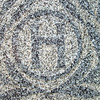Just read Adam Greenfield’s blog entry “Reality bites“. He describes how a design he produced for a friend’s new restaurant became a solid metal sign within days. Despite knowing about recent rapid fabrication techniques, actually seeing these processes in action for his own design was still shocking.
I too am still amazed at the relative ease that ideas can be turned into reality. In a presentation “As we may print” at the 2003 Interaction Design for Children, Michael Eisenberg described how he and his co-workers at University Colorado were using laser cutters to enable children to design their own 3D designs in card or even thin plywood. More recently at the National Centre for Product Design and Development Research in Cardiff, I saw 3D metal printers. I was aware of 3D printers working in various gels and foams, but did not realise it was possible to create parts in titanium and steel, simply printed from 3D CAD designs. Chasing one of Adam’s links I found instructions to make your own 3D printer on the MIT site … however, this constructs your designs in pasta paste not metal!
One of the arguments we are making about our FireFly technology is that it will change lighting from being a matter of engineering and electronics, to a digital medium where the focus moves form hardware to software. While FireFly allows more flexible 2D and 3D arrangements than other technologies we are aware of, it is certainly not alone in making this transformation in lighting. Last week I was talking to Art Lights London and they are planning some large installations using Barco’s LED lighting arrays. Soon anything that you can point on your computer screen you will also be able to paint in light from your own Christmas tree to London Bridge.
Although it sometimes seems that technology is simply fuelling war and environmental catastrophe, it is a joy to still glimpse these occasional moments of magic.



